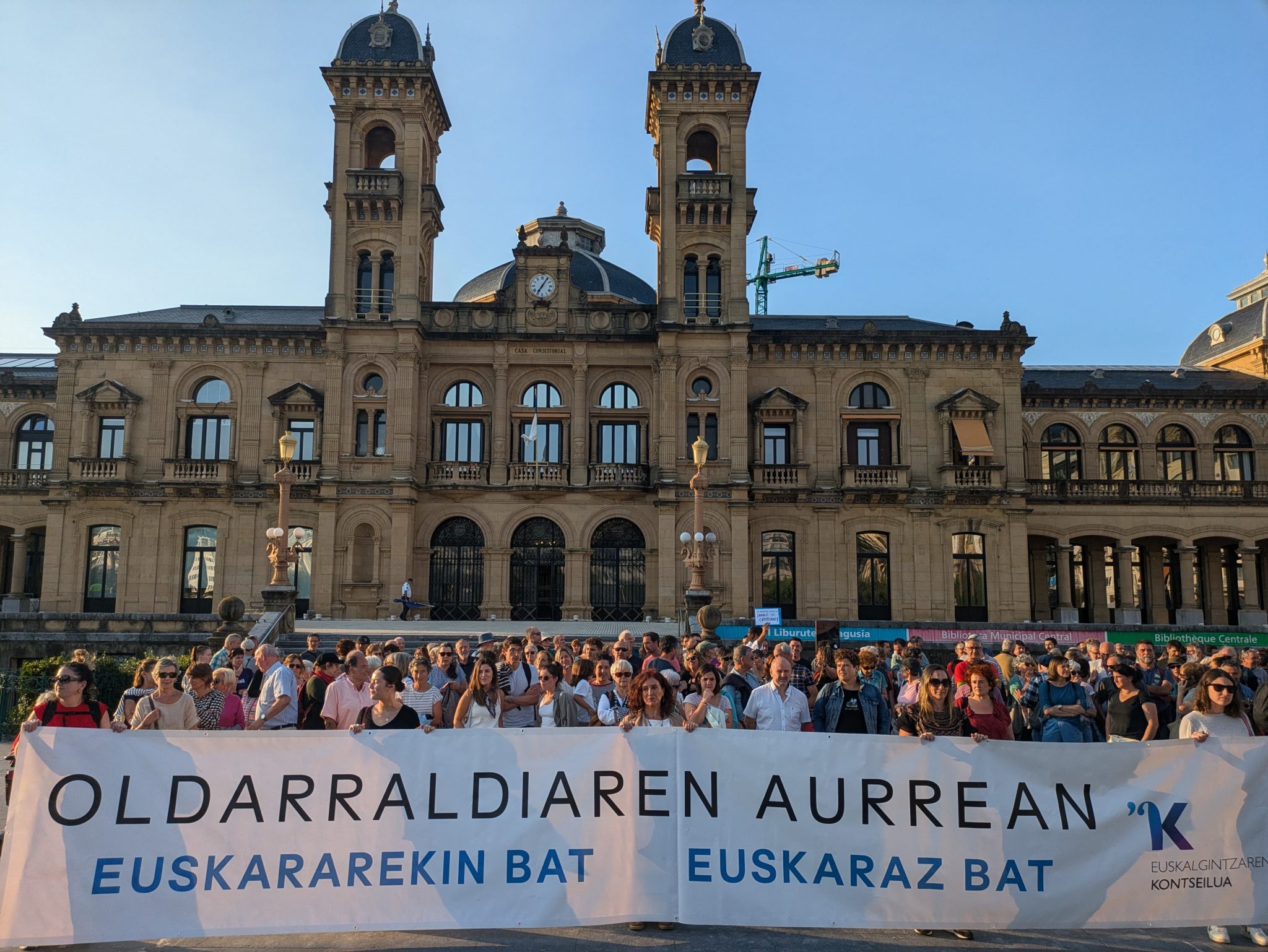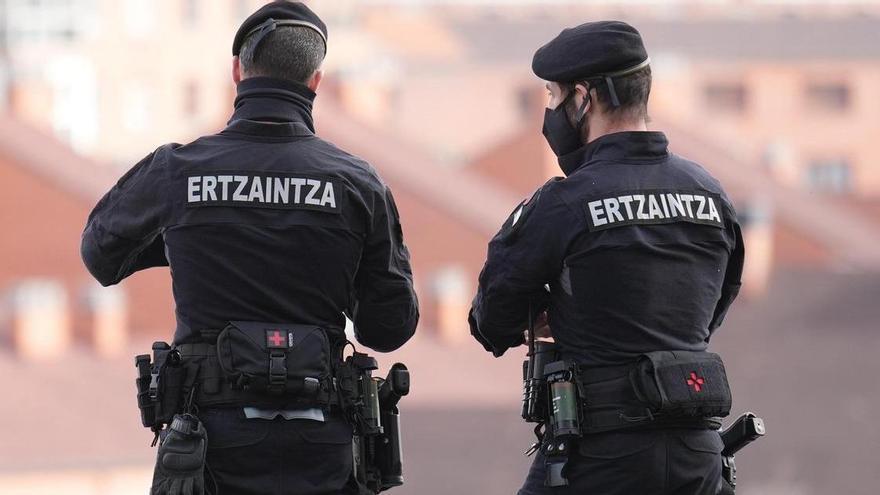The circuit to ensure care in Basque in the rehabilitation unit of the Donostia Hospital
- In the rehabilitation unit of the Donostia Hospital, a bilingual circuit has been launched to ensure that users who so wish can receive all the care in Euskera. It has professionals from all the services offered in it.

“To guarantee professionals that this is the case for people who seek care in Basque.” Using these words, Ander Zuloaga, a technician from the Basque section of the Donostia Hospital, has summed up the bilingual circuit that has begun in the rehabilitation unit. The circuit consists of a series of health professionals who will be with the patient. The goal is for the entire chain of workers to speak to the patient in Basque. The creation of a bilingual circuit in the specialties is a proposal included in the II Plan of the Basque Country of Osakidetza, which is already obligated in the primary care system.
Prior to the implementation of the circuit, an examination was carried out in collaboration with the medical and nursing departments. In the specialties, the level of knowledge of Euskera was analyzed and the possibilities of implementing the circuit were reflected. Thus, they concluded that the rehabilitation unit of the Hospital Donostia was adequate to start the project, since the level of knowledge of the professionals was adequate, on the one hand, and on the other it would be manageable in the circuit performed by the patients inside.
They then went to the rehabilitation unit to make a proposal to their managers. The first steps of the meeting were explained to the section heads, José Artetxe, Javier Barrera and Ana Belastegi, among others. The members of the Euskera group analyzed the work dynamics of the unit and realized that the circuit could be established. After all, Zuloaga has said, to make a bilingual circuit is to follow some guidelines. For example, when they detect a patient who wishes to be cared for in Euskera, either by their medical record or by having requested it at the entrance, they offer it. The Basque department has set up the circuit and offered assistance to the professionals of the Basque country.
Among those who do guarantee care in Euskera are Dr. Xabier Valencia, physiotherapist Araitz Maeztu and nurse supervisor Igone Esnaola. Valencia explained that the heads of the unit were in charge of knowing the test circuit. In his opinion, “it is important to be sensitive to the Basque Country, and so are the heads of the unit”. It recognizes that it has not been very difficult for them to assimilate the project: “Almost two years ago, those of the Service had to draw up a strategic plan to boost the Basque country. We have a very interiorized service.”
Circuit efficiency
The four professionals consider that the circuit is making a good way: “The resources are on all floors, but here they are applied much more rigorously because of the circuit,” explains Zuloaga. One of these is the possibility of introducing linguistic priorities into the computer system. According to Maeztu, “when they come to the rehabilitation area we ask them, but when they are chosen in the computer system they remain there and it can work perfectly.”
Asking each patient in which language they want is a consequence of the reflection made during the preparation of the circuit, and it is not the only improvement that the reflection has supposed, according to Zuloaga: “I’m sure looking at language preferences on your computer becomes more here than elsewhere.” However, not everyone participated in the reflection process. Maeztu did not appear, for example: “It seems to me that reflection is to sensitize the process, and I think it was previously sensitized. I’ve been involved in the preparations.” However, he stressed that there were many people who reflected, “even from other centers”. Two types of preparation were performed. First some reflection sessions were held and then the formation phase began, according to Zuloaga, which was a kind of course to work in Euskera.

Everyone thinks that the role of those responsible is very important. Zuloaga says they are important in encouraging professionals and transmitting things. According to Maeztu, those responsible are key in facilitating the preparation of this project, “they have become more flexible in terms of schedules and have had a good attitude in granting permits”.
About 100 people walk through the bilingual circuit. All workers in the rehabilitation unit are part of the circuit, but not all can guarantee care in Basque. Most are nurses, nursing assistants and about 40% are vasco-speakers. Among the physiotherapists, the highest number of vasco-speakers stands out, eight out of ten. They're above average. On the other hand, more than half of the doctors are Basque.
The key is daily life.
The effectiveness of the circuit is measured on a daily basis. Professionals take concrete steps to ensure care in Basque: “I visit hospitalized patients every day and if they have identified the language in which they want to be cared for, it is very easy,” said Valencia. So if you want attention in Basque – among other things, you put it on the slates above the bed – you do it directly in Basque. On the contrary, if there is no identification, the doctor first addresses himself in Euskera: “I greet you in Basque and we play based on your response. If he answers in Basque, we continue like this, and if not, we ask him what he prefers,” said Valencia.
The appearance of the linguistic option on the board does not occur on all floors. This is a measure taken in the rehabilitation unit, within the reflection process: “If it is done on the other floors it is by imitation, because we have expanded it, but it was proposed by the nurses here in the elaboration of the circuit,” said the head of Euskera.
They also have other measures: “When we see a patient and decide which therapy he needs, we give a record to the workers of that therapy. In the case of Euskaldunes patients, we place a stamp on the medical record, if possible to ensure care in Euskera in the therapy”, explains Valencia.
Maeztu has pointed out that an “e” in the clinical history can also be used to select the Basque language. Igone Esnaola, head of the apartment, is dedicated to them: “I see every day all the hospitalizations and if I see that he has an “e” in the medical record, I go to the blackboard that is next to his bed. It’s usually put, because nurses have taken the habit.” The supervisor also tries to alert the workers. He says that there are many changes of people on the floor, as far as nurses are concerned, and he always reminds them that on the last page of the leaflet that gives the instructions there are indications about the Basque country, “that you have to take good care”. The rehabilitation plant is frequented by workers who have a booklet to give details: “On the back page there are explanations about Euskera, and we tell them to look at them.”
The use of Euskera is not much demanded by the users. Many times, because of ignorance. Even so, Zuloaga has underlined that once they are presented with the bilingual circuit they make a very positive assessment: “If there were prejudices and they knew they had the opportunity to speak in Basque, they would ask for more.” The four agree that the Basque language has been more widely used since the beginning of the circuit: “The circuit is composed of very small details, but the change is total,” concluded Esnaola.
Euskal Herrian Euskarazek manifestazioa deitu du apirilaren 6rako, 11n EHEko bi kide epaituko dituztelako. Hiriburuetatik autobusak antolatzen ari dira. Bi helburu bete nahi dituzte, batetik, epaituak izango diren bi kideei babesa erakustea, eta bestetik, euskararentzat justizia... [+]
ELA sindikatuak azaldu duenez, azken Lan Eskaintza Publikoaren oinarrien arabera, Ertzaintzarako eskainitako lanpostuen %20ak eta Udaltzaingoaren %30ak ez daukate euskara-eskakizunik. Gasteizen, adibidez, udaltzain-lanpostuen erdietan, 24tan, ez dago euskara-eskakizunik.
Ba al dakizue frantses batzuk harritu egiten direla mugaren alde honetan ere euskaldunak bagaudela jakitean? Ba bai, harrigarria bada ere, behin, Donostian, frantses batzuei entzun nien sinetsi ezinik beren buruari galdetzen: “Saint-Sébastien est au Pays... [+]
"No entiendo, en castellano por favor" eta gisakoak ohikoak dira eskolako guraso Whatsapp taldeetan, baina Irungo Txingudi ikastola publikoan euskara hutsean aritzeko modu erraz eta eraginkorra dute, behar duenarentzat itzulpen sistema berehalakoa ahalbidetuta.
Gabonetako argiak pizteko ekitaldia espainolez egin izanak, Irungo euskaldunak haserretzeaz harago, Aski Da! mugimendua abiatu zuen: herriko 40 elkarteren indarrak batuta, Irungo udal gobernuarekin bildu dira orain, alkatea eta Euskara zinegotzia tarteko, herriko eragileak... [+]
The Council of Euskalgintza is warning of the linguistic emergency we have been experiencing in recent weeks. Several years have passed since the beginning of describing the situation of the process of revitalization of the Basque country at the crossing, at the roundabout, at... [+]
Korsikako legebiltzarkideek ezin dute Korsikako Asanblean korsikeraz hitz egin, Bastiako Auzitegiaren 2023ko epai baten arabera. Ebazpen horri helegitea jarri zion Asanbleak, baina debekua berretsi du orain auzitegi berak. Epaiak tokiko beste hizkuntzei eragiten diela ohartarazi... [+]














.jpg)








